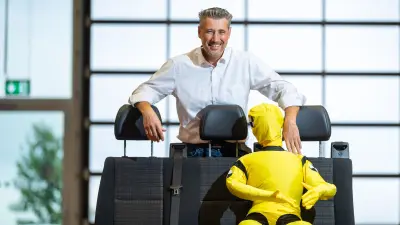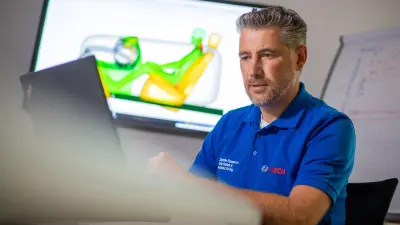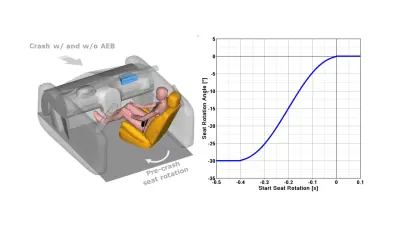Your automated driving trip – how we create a really safe trip using human body models
Bosch Research Blog | Post by Gian Antonio D’Addetta, 2021-04-20

Application of human body models (HBM) to analyse the challenges of rotating seats in future crash scenarios involving highly automated vehicles.
Imagine travelling on a highway in a not-so-distant future. As usual, on the two-hour trip back home from your parent’s house you enter the highway, switch to automated driving mode and electrically move your seat to a relaxed lounge position by inclining your seat and rotating it towards the screen in the middle console of your car. Now the relaxing begins. You start watching your favourite series via the in-car entertainment suite. After a while, you fall asleep and are awoken by a loud bang, a strong fixation of your seat belt and a deployed airbag, strange smells and odours. Still shocked, you unfasten your seat belt and open the door. What happened? You and your car were involved into a crash.
Fortunately, your car is equipped with Bosch safety systems, which has protected people in the past and it will continue to do so in the future.
- lives worldwide were saved by Bosch’s electronic airbag control unit since production started in 1980.
Learn more about accident research on my colleague’s profile:
Thomas Lich
New accident situations in automated driving scenarios
At Bosch Research, we take care of innovative solutions for the vehicle safety of the future. A future in which the combination of automated and non-automated driving has become reality and the interiors of vehicles are much more focused on the needs of the occupants than today. But one thing is certain: There will still be accidents, especially in the transition phase from non-automated to automated vehicles when there will be both kinds of cars on the road. We want to solve the challenges of this so-called “mixed traffic” and provide adequate safety solutions for all vehicle occupants, those in automated but also those in non-automated cars.

Independent of the implementation of safe automated driving, the challenges in vehicle safety lie in controlling new accident situations and in the realistic representation of the various occupants. New freedoms in the interior allow for a wide variety of sitting positions and occupant poses. Occupant protection can no longer be ensured simply through crash tests in a lab. Imagine how many situations, configurations and scenarios would have to be tested. This would simply be too expensive. Modern simulation methods are called for here.
Digital mapping with virtual human body models
Crash and occupant simulation based on Finite Element and Multibody Dynamics helps to deliver ideas for the development of protective systems such as the control of restraint systems. One main focus of our research is on the digital mapping of occupants using virtual human body models. To make this happen, we collaborate with well-known partners in industry and research and contribute to publicly funded projects. One of these projects is the European project “OSCCAR – Future Occupant Safety for Crashes in Cars”. Our work with digital human models allows for a detailed description of the vehicle occupants’ kinematic behaviour before and during an unintentional collision.
As pointed out previously, in the transition period from conventional to automated driving, vehicle passengers will benefit from an increased spatial freedom, along with potential changes in interior design and seating positions. To ensure occupant safety in rotating seats, innovative protection principles are required. As part of the OSCCAR project, we simulated the effects of seat rotation prior to a crash, whereby the rotating seat and its occupant are repositioned into a more beneficial situation. Typically, if we start with innovation actions or research activities, we are guided through initial hypothesis formulated in form of research questions.
Our research question: What influence does a seat rotated pre-crash have on occupant position and safety?
By the application of the Simcenter Madymo Active Human Model (AHM), we demonstrated the capabilities to measure the effects of seat rotation by using active, motorized seat rotation. As outlined in our introductory example, in the initial position, the passenger seat was rotated up to 30° inwards. A complete pre-crash and in-crash scenario involving a typical compact car configuration was simulated.
We could show that by actively turning the seat by 30°, the occupant impacts the passenger airbag more in the center compared to the baseline situation. In addition, passenger neck-to-seat-belt contacts much like those seen in far-side crashes were observed. Generally, automatic pre-crash braking yields a better coupling of the occupant to the vehicle in a crash. Thus, it improves the overall repositioning effects and results in overall lower loads on the occupant. Based on the rotation duration, velocity and rotation axis, the HBM response allowed for a recommendation of an adequate repositioning characteristic of the occupant. We showed that the repositioning mechanism can bring the occupant closer to a more beneficial position prior to a crash.

Study: Automated driving situation with a rotated seat
In our study, we used a highly parameterised generic multibody interior model that was created for the OSCCAR project to study parameter variation effects in a design of experiment (DoE) study and to analyse the efficiency of new innovative protection principles. It is based on the Simcenter Madymo Active Human Model (AHM) and contains state-of-the-art restraint systems and seat models. The Human Body Model used in this study is validated for frontal, lateral (combined frontal and lateral), rear and vertical loading conditions. Thereby, the intervertebral discs of the neck and spine are modelled according to point and cardan restraints that are based on stiffness data from literature. The interior model is highly parameterised in order to study parameter variation effects in a design of experiment (DoE) study or optimisation.
-
Fig. 1. Protection principle scheme (left) and example for the seat rotation curves starting at T = -400 ms (right).
The analysed scenario represents an automated driving situation on a highway with an occupant sitting in a rotated seat. Automatic emergency braking by an advanced driver assistance system may occur before the collision, however, possible steering manoeuvres are not considered in this study. The overall motivation for this protection principle is to ensure occupant safety in rotating seats (rotation around z-axis, see Fig. 1, left). The passenger on a rotated seat is repositioned into a close-to-standard, frontal-facing position prior to a vehicle collision. The rotation curve is characterised by a spline interpolation (see Fig. 1, right) and represents a plausible kinematic behaviour of the seat. Initially, the occupant is sitting slightly rotated and pointing away from the driving direction. The initial situation includes a seat rotation of up to 30°. The seat rotation velocity and the starting time of pre-crash rotation are varied in the simulation study. The pre-crash rotation of the seat terminates at T = 0 ms, which defines the point in time when the pre-crash phase ends and the collision starts. After that point, the “regular” restraint systems like airbag and pyrotechnical seat belt tensioner will be trigger and take action some milliseconds ahead.
The DoE simulation study was organized according to predefined conditions. These simulation studies are thought as pre-studies to define plausible and adequate sets of rotation parameters in the pre-crash phase. Finally, they shall facilitate more detailed studies for the crash phase with more complex and numerically more time-consuming HBMs like the THUMS model. The effect of the protection principle is investigated at the time of the collision T = 0 ms and at T = +45 ms, just before the occupant contacts the passenger airbag. As an example, screenshots of two simulation runs are presented in Fig. 2. In the top row, seat rotation starts at T = -400 ms and ends at T = 0 ms, while seat rotation starts at T = -100 ms and ends at T = 0 ms in the bottom row.
-
Fig. 2. Simulation run (top view): rotation starts at T = -400 ms and ends at T = 0 ms (top), rotation starts at 100 ms and ends at T = 0 ms (bottom)
Results
- Faster rotation velocities yield higher deviations between seat and occupant body before the crash starts and the restraint systems are activated.
- The faster the rotation velocity, the higher the average pre-crash average occupant accelerations (e.g., up to 9 g for a very fast seat rotation of 30° in 50 ms).
- For those cases shown in Fig. 2, levels of 1 g (T = -400ms) and 4 g (T = -100ms) are reached. In order to estimate these values, one needs to consider that in the following crash phase, average acceleration levels of 40 – 60 g are typically achieved depending on the body region.
- For the case of a seat initially rotated by 15° instead of 30°, the picture does not change. However, the maximum pre-crash accelerations are limited to max. 3 g with fastest rotation velocity.
- As an outcome, a rotation velocity of 30° for 350 ms was identified as plausible setting and used throughout the more detailed studies.
To conclude, in these pre-studies, we demonstrated that the relative movement of the occupant to the seat can be used as a measurement of how well the occupant is repositioned and follows the seat movement. In general, automatic emergency braking (AEB) improves the guidance between the occupant and the seat belt. This means the occupant is better prepared for the coming collision through a better coupling to the seat belt. The higher the rotation velocity of the seat, the lower the guidance of the occupant to the seat. Therefore, a timely rotation in the pre-crash phase is beneficial with respect to the relative position of the occupant to the seat at the beginning of the in-crash phase.
Discussion
This practical example with a rotating seat in the pre-crash phase shows that HBMs will allow us to create and assess pre-crash safety systems for future accidents. It must be noted that the results presented in this blog represent intermediate results. It is worth mentioning that these results are very helpful in designing pre-crash functions and the according logic within the safety control units of future vehicles. Furthermore, they are helpful for identifying requirements of electric drives for the pre-crash actuation of seats in new interiors. Further simulation studies with the described protection principles and other principles are currently underway at Bosch and as part of the OSCCAR project.
Acknowledgement: The presented work by Maja Wolkenstein and Gian Antonio D’Addetta was carried out within the EU H2020 project “OSCCAR – Future Occupant Safety for Crashes in Cars”. OSCCAR has received funding from the European Union’s Horizon 2020 research and innovation programme under grant agreement No. 768947.
What are your thoughts on this topic?
Please feel free to share them via LinkedIn or to contact me directly.
As a team leader for research topics in vehicle safety, Gian develops new concepts for the protection of vehicle occupants in new interiors, but also safety systems that become active in newly emerging accident scenarios together with his team.





